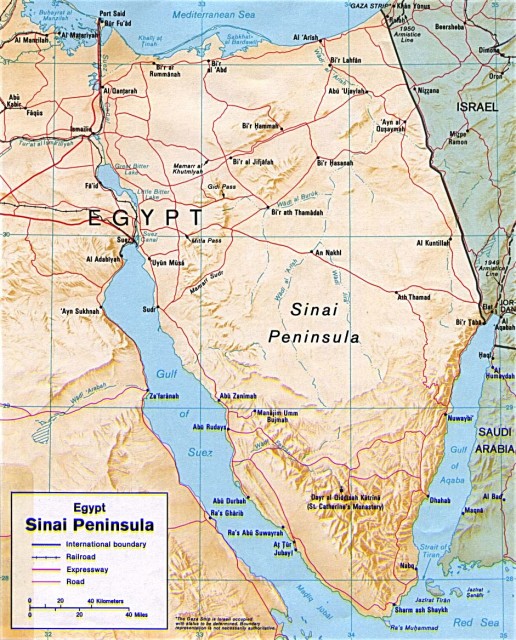Sinai Peninsula
THE SINAI PENINSULA (in Arabic, the Shibh Jazirat Sina) is the eastern extension of EGYPT onto the continent of Asia (Egypt being mainly in Africa), bordering on the country of ISRAEL. The western boundary of the peninsula is formed by the Gulf of Suez and the Suez Canal, while it is separated from SAUDI ARABIA and JORDAN to the east by the GULF OF AQABA. The southern tip of Sinai points into the RED SEA, while the eastern MEDITERRANEAN SEA bounds its northern shores.
The Sinai Peninsula is 23,400 square mi (67,000 square km) in area, with a population of approximately 300,000. The land is arid, with relatively few oases at which the bulk of the population is located, although there are also Bedouin following a nomadic lifestyle with their tents and herds. Its physical geography is characterized by three major regions: the sandy coastal plain of the north, the high limestone plateau in the center, and the mountains of the south.
These mountains are associated with the biblical account of the flight of the Hebrew people from Egypt. This event is generally believed by scholars to have taken place during Egypt's New Kingdom period, and some scholars have suggested Ramses II as the pharaoh of the Exodus account. According to the Exodus narrative, the Hebrews trekked southward from their crossing of the Red Sea to Mount Sinai, also known as Mount Horeb. There they encamped while God gave Moses the Ten Commandments, enscribed on two tablets, as well as various other laws.

Traditionally the biblical Mount Sinai has been identified as an 8,000 ft (2,400 m) peak near the southern tip of the peninsula, known in Arabic as Jabal Musa (the Mountain of Moses). Several religious communities have been located on or near it over the centuries, including a Greek Orthodox monastery and a Sufi school. However, some modern scholars have suggested, based upon new understanding of the Hebrew language, that the actual Mount Sinai may be another peak farther to the north.
In modern times, the Sinai Peninsula was first formally associated with Egypt by the Islamic empire which arose in the 600s, shortly after the life of Muhammad. This association with Egypt was formalized in the 1906 agreement between the United Kingdom and the OTTOMAN EMPIRE (modern Turkey), which set many of the critical boundaries in the Middle East.
It became the locus of further conflict following the 1948 establishment of the state of Israel, and after the 1967 Arab-Israeli War, it was occupied by Israeli forces. In 1982 Israel withdrew its forces in return for Egypt's recognition of Israel's right to exist, in accordance with terms set down in the 1978 Camp David accords brokered by U.S. President Jimmy Carter. However, a dispute at Taba on the Gulf of Aqaba continued until 1989.